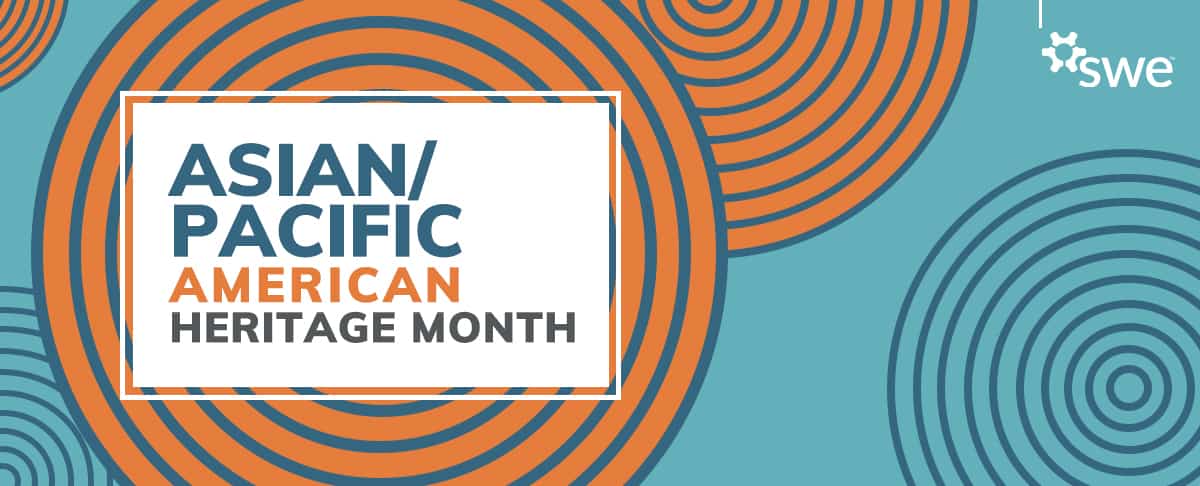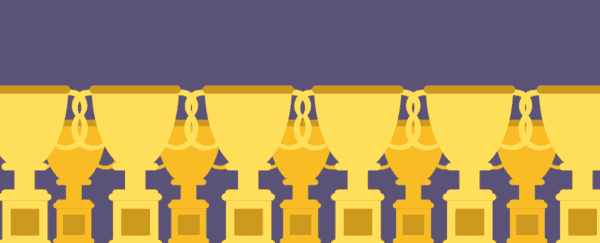In celebration of Asian Pacific American Heritage Month, SWE will be highlighting Asian American women engineers in a series of blog posts.
In this article, we will be highlighting Sarah Koenig (Deputy Production Chief at Pratt and Whitney), Upekesha Addagatla Ngugi (Flight Controls Design Engineer at The Boeing Company), and Kristine Loh (BS/MS Student at Drexel University).
Sarah Koenig (Deputy Production Chief at Pratt and Whitney)
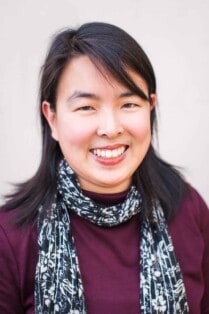
Sarah Koenig is Deputy Production Chief, Industrialization at Pratt and Whitney. She is responsible for the industrialization of key configuration changes on the Next Generation Product Family (NGPF) Regional Jet family of engines. She earned her BS Industrial Engineering and BA French from the University of Rhode Island and her MBA from Carnegie Mellon University. Sarah is a SWE Lifetime member.
Tell us about your background: Where are you from, and what attracted you to the world of engineering or STEM?
I was born in South Korea and adopted by an American family when I was an infant. I grew up in upstate New York, went to college in Rhode Island, and then moved to Connecticut for work. My interest in engineering was first sparked by my high school physics class– it was the first science that really clicked for me, and I loved it. As I learned more about engineering, I realized what a good match it was for my methodical approach to things.
What has been the biggest obstacle you’ve overcome to be where you are today?
Believe it or not, it was my own fear. When I first started in my career, I was afraid to disagree with others, either because they might get angry at me or because I might be wrong. Over time, I learned to trust my instincts, and speak up. If they got mad at me, so what? As long as I was objective and factual, it wasn’t about them personally. I gained confidence in my knowledge and experience, and knew that even if I was wrong, that my position was made to the best of my ability, and it could be an opportunity to learn.
What has been your personal experience as a (double) minority in STEM? What surprises (good or bad) have you encountered?
Early in my career, I experienced more adversity based on my age than my gender or ethnicity. I still experience it to some degree today, since I look younger than my actual age. I have experienced comments such as “I’ve never worked for an Asian before” and “I didn’t know that you were Asian” (thanks to the increasingly virtual world that we work in across the country and world) like it was going to be a factor in how things would be moving forward. For the most part, I have been lucky to have co-workers and managers who believe that my gender or ethnicity does not affect my performance.
What’s the best thing to happen since you became involved in SWE?
The friendships! My closest friends (who are also my most trusted advisors) are all people I’ve met through SWE. No matter what personal or professional problem I may be facing, I know that there is someone in my SWE network who I can turn to for help, advice, or a sympathetic ear. I have several SWE friends who no longer are local (or never were), but we make an effort to see each other whenever possible, whether it be at the annual conference or elsewhere. What may have once been a solo business trip dinner becomes a time to catch up over good food and wine!
What’s it like to be an engineer in your field?
I have often suffered from Imposter Syndrome because I have spent my career in quality, supply chain, and operations, and never worked for the engineering organization at my company despite having an engineering degree. My engineering training provides me with a methodical approach to problem-solving the many challenges that present themselves and allows me to understand the more technical problems in order to offer better solutions or calculate the impact on my work. I rely on my ability to work cross-functionally more than my technical abilities, most days.
Upekesha Addagatla Ngugi (Flight Controls Design Engineer at The Boeing Company)
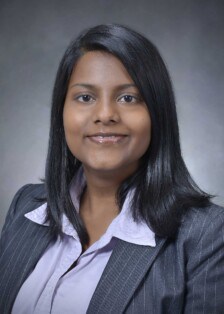
Upekesha Addagatla Ngugi is a Flight Controls Design Engineer at The Boeing Company. She was born in Hyderabad, India and moved to Dallas, Texas during high school. Mentoring, networking, SWE leadership roles have played a key role in her professional development and helped her empower future women in STEM.
Tell us about your background: Where are you from, and what attracted you to the world of engineering or STEM?
I was born and raised in Hyderabad, India. I emigrated to Dallas, Texas, USA as a high school student. My father is an engineer and encouraged us to pursue a technical career. Due to the competitiveness in India, engineering or medicine were always my two choices. The choice of medicine was out because I knew I didn’t want to deal with blood. I enjoyed math and programming classes in high school. During a family trip to the NASA Space Center in Houston, TX we got to see the X-38 vehicle up close and participated in a teleconference with astronauts in space at the time. This led me to choose a career in Aerospace Engineering.
What has been the biggest obstacle you’ve overcome to be where you are today?
Indian women are taught to be humble, and not question men or elders. This has been one of the biggest obstacles I had to overcome in my career. Thankfully, I had role models and mentors at work and through SWE that helped me realize that this behavior didn’t serve me well in the workplace. They helped me learn when to be humble, when to advocate for myself, and when to respectfully speak up to do the right thing for the project.
What’s it like to be an engineer in your field?
As a Flight Controls Design Engineer, I perform complex fluids analysis and create designs in CATIA to meet given requirements. CATIA is a software used to model 3D designs through computer-aided engineering. I enjoy the challenge of finding solutions to create a design to meet difficult requirements. Seeing an airplane I worked on fly for the first time and visiting the factory to see parts I work on are exciting things I look forward to. The walks on the massive Everett factory floor truly make you feel small. I’ve been fortunate to have a variety of experiences working with airline customers, various engineering groups, suppliers, and regulatory agencies.
What has been your personal experience as a (double) minority in STEM? What surprises (good or bad) have you encountered?
Since I work in the Aerospace Industry, I am usually the only Indian woman in the room. I didn’t expect this and was surprised to see this when I started working. I learned to network with people of various cultural backgrounds through my interest in cooking and traveling. The SWE network of over 40,000 women, especially the affinity group members, that are going through similar situations helps me make connections I don’t normally have an opportunity to. One of the good surprises is that my problem-solving skills translate at home to activities I enjoy like assembling furniture and replacing electrical switches.
Why do you like to volunteer in SWE? What motivates you to contribute more?
I like to volunteer with SWE because it is a good way for me to network with other women engineers since I don’t see as many at work every day. Since I discovered the value of SWE and other similar organizations later in my career, I continue to mentor early-career engineers, collegiate and K-12 students so that I can be a role model that I didn’t have. Closing the gender and cultural gaps in the STEM industry are reasons that motivate me to contribute more. Volunteering as a FIRST robotics mentor and similar volunteering experiences help me practice my engineering skills and learn more about 3D printers, mills, lathes, and other manufacturing techniques.
Kristine Loh (BS/MS Student at Drexel University)
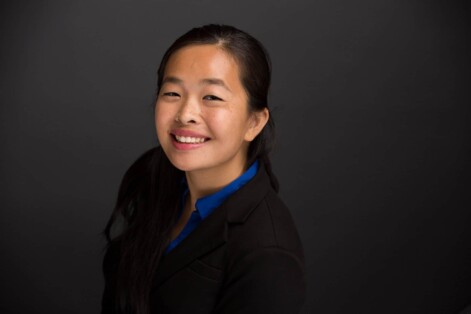
Kristine is currently a senior at Drexel University pursuing her BS in Chemical Engineering and her MS in Materials Science and Engineering. She will be attending the University of Minnesota Twin Cities in Fall 2020 for her PhD in Chemical Engineering. Her passion for improving diversity and inclusion in STEM leads to her heavy involvement in the Society of Women Engineers on the collegiate and Societal levels. In her free time, she loves to try out new air fryer recipes.
Tell us about your background: Where are you from, and what attracted you to the world of engineering or STEM?
I was born and raised in Hialeah, Florida, a small town near Miami with less than 1% Asian population. In school, I always loved math and science, so engineering felt like a natural career for me. It wasn’t until I actually took engineering classes in high school through the Project Lead the Way program that I really understood what engineering was. I tried mechanical and electrical engineering and it didn’t really fit. I wasn’t enjoying what I was learning, but I still liked the problem-solving aspect. When we learned about manufacturing, it was the first time I could see myself as an engineer. This led me to choose chemical engineering as my major in college. I decided to add a master’s degree in materials science and engineering to my course of study because I wanted to understand why materials behave the way they do.
What has been the biggest obstacle you’ve overcome to be where you are today?
My biggest obstacle has been myself. Growing up, my parents always stressed the importance of humility. No one likes an arrogant person, so I was taught to always be humble no matter what I accomplished. However, this manifested in me denying my success and pushing down my feelings of validation. I struggled with a lot of self-doubt and imposter syndrome throughout college to the point where I felt like I didn’t deserve what I had done; I was just lucky. Perfection didn’t seem like enough for me. Through counseling and self-compassion workshops, I’ve grown to embrace my hard work and learn that I am good enough just the way I am.
What has been your personal experience as a (double) minority in STEM? What surprises (good or bad) have you encountered?
Different facets of my identity get pinpointed depending on my environment. During my internships, people made more comments about my ethnicity. At my first internship, I got called the names of the three other Asian women in the company. One person said that we looked the same from behind, even though we all had different hair colors. In the classroom, my professors and peers seem to treat me differently because I’m a woman, not because of my heritage. On the bright side, I’ve been able to use my identity to educate others about my perspectives. At my last internship, I introduced my coworkers to Lunar New Year and was able to make a product based off the holiday.
Tell us how you first got involved with SWE.
I joined SWE during my freshman year at Drexel. Even before I got to college, I knew I wanted to join SWE because I was usually one of the only girls in my high school engineering classes. I was really excited to join an organization where I wouldn’t be the only one. I became the K-12 Outreach Chair just three months after I got to college and moved my way up to president by my third year. I didn’t grow up with mentors in STEM and I knew I wanted to be that person for other young engineers. I love sharing with K-12 students why I chose to be an engineer.
What’s the best thing to happen since you became involved in SWE?
I like to call SWE my cheer squad. Even when I felt like I didn’t deserve success or praise, SWE was there to cheer me on. The SWE community is one of the main reasons I’ve stayed in engineering. I’ve met some of my closest friends through my involvement in SWE. I’ve also met some of the most inspiring mentors and I hope to be the same type of mentor someday. Because of the opportunities and experiences I got through SWE, I’ve grown so much as a leader, an engineer, and a person overall. I don’t think I can choose just one great thing that SWE has done for me.
Related Content
- Podcast: Celebrating APA Heritage Month with Past SWE President, Nora Lin
- Asian Pacific American Heritage Month: Highlighting Asian American Engineers Pt. 1
- Celebrating Asian Pacific American Heritage Month
Author
-

SWE Blog provides up-to-date information and news about the Society and how our members are making a difference every day. You’ll find stories about SWE members, engineering, technology, and other STEM-related topics.

